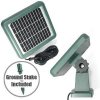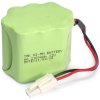Hi All, here's the backstory...
I decided to try a little experiment in the garden this year by cutting out the bottoms of plastic milk jugs and placing them over some of my new veggie plants to see if they would be effective at protecting them against late spring frosts. Nigh before last we had a doozey and the survival rate was about 50%, so I'm thinking... damn, if I had been able to keep the temp in the milk jugs like 1/2 a degree to a degree warmer, I probably wouldn't have lost much at all.
So after wracking my brain for a while, I got this idea, and since I'm not well versed in anything related to electronics, I thought I'd throw it up here and let the experts start telling me where the holes are in my plan!
The plan (pilot date next spring) is to convert some of those cheap solar path lights to solar heaters by switching out the photoresistor with a thermistor, so that instead of the LED coming on at dark, it comes on at cold.
I know LED's don't produce much heat, but I don't think much is needed and it'd be great to keep these battery/solar operated so I don't have a million wires running all over the garden. If anyone has any suggestions for replacing the LED with something that may generate more heat, while using a similar amount of power, I'm all ears!
So, does this sound like a realistic idea to anyone? If not, are there any suggestions to achieve a similar result?
Also any suggestions as to what I may need to consider when choosing a thermistor would be very much appreciated as I know exactly nothing
Thanks,
Joe
I decided to try a little experiment in the garden this year by cutting out the bottoms of plastic milk jugs and placing them over some of my new veggie plants to see if they would be effective at protecting them against late spring frosts. Nigh before last we had a doozey and the survival rate was about 50%, so I'm thinking... damn, if I had been able to keep the temp in the milk jugs like 1/2 a degree to a degree warmer, I probably wouldn't have lost much at all.
So after wracking my brain for a while, I got this idea, and since I'm not well versed in anything related to electronics, I thought I'd throw it up here and let the experts start telling me where the holes are in my plan!
The plan (pilot date next spring) is to convert some of those cheap solar path lights to solar heaters by switching out the photoresistor with a thermistor, so that instead of the LED coming on at dark, it comes on at cold.
I know LED's don't produce much heat, but I don't think much is needed and it'd be great to keep these battery/solar operated so I don't have a million wires running all over the garden. If anyone has any suggestions for replacing the LED with something that may generate more heat, while using a similar amount of power, I'm all ears!
So, does this sound like a realistic idea to anyone? If not, are there any suggestions to achieve a similar result?
Also any suggestions as to what I may need to consider when choosing a thermistor would be very much appreciated as I know exactly nothing
Thanks,
Joe




